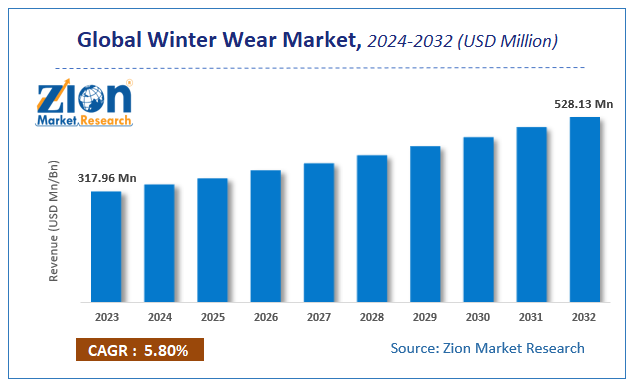Winter Wear Market Size, Share Report, Analysis, Trends, Growth 2032
The winter wear market encompasses a wide range of clothing designed to keep people warm during the cold winter months. This market includes various types of apparel such as coats, jackets, sweaters, thermals, scarves, gloves, and hats, catering to different segments of the population.

Get a Free Sample : https://www.zionmarketresearch.com/sample/winter-wear-market
Key Aspects of the Winter Wear Market:
Market Growth:
- The winter wear market has been growing steadily, driven by the increasing consumer focus on fashion, rising disposable incomes, and the need for functional and stylish winter clothing. Additionally, the expansion of e-commerce platforms has made winter wear more accessible to a global audience.
Consumer Segments:
- Men's Wear: Includes jackets, coats, sweaters, thermals, and accessories like gloves and scarves.
- Women's Wear: Encompasses a wider variety of clothing and accessories, with a significant emphasis on fashion trends and seasonal collections.
- Children's Wear: Focuses on warmth, comfort, and safety, with clothing designed to be easy to wear and maintain.
- Sports and Outdoor Wear: This segment caters to individuals engaging in outdoor activities such as skiing, snowboarding, and hiking, requiring specialized winter gear.
Product Categories:
- Jackets and Coats: The most significant segment within winter wear, including puffer jackets, parkas, trench coats, and wool coats.
- Sweaters and Cardigans: Knitwear remains a staple in winter collections, with options ranging from casual to formal styles.
- Thermals: Base layers that provide insulation and are often made from materials like wool, cotton, or synthetic fibers.
- Accessories: Scarves, gloves, hats, and socks are essential for complete winter protection.
Materials and Fabrics:
- Wool: A traditional fabric known for its warmth and durability.
- Down: Used in jackets and coats, down is prized for its insulation properties.
- Synthetic Fabrics: Materials like polyester, fleece, and acrylic are popular for their moisture-wicking, lightweight, and insulating qualities.
- Eco-friendly Materials: There is a growing trend toward sustainable and eco-friendly materials, such as recycled polyester, organic cotton, and ethically sourced down.
Trends:
- Sustainability: Consumers are increasingly looking for eco-friendly and ethically produced winter wear, driving brands to adopt sustainable practices.
- Fashion Integration: Winter wear is no longer just about functionality; fashion-forward designs and seasonal collections are key drivers in the market.
- Technological Innovation: Smart fabrics, heated clothing, and water-resistant materials are gaining popularity, especially in the outdoor and sports segments.
- Customization and Personalization: Brands are offering customizable options to cater to individual preferences and styles.
Distribution Channels:
- Online Retail: E-commerce platforms are becoming the preferred shopping destination for winter wear, offering convenience, a wide range of products, and easy comparison.
- Department Stores and Specialty Retailers: Physical stores remain important, particularly for high-end and luxury winter wear brands.
- Discount Stores and Outlets: These channels cater to price-sensitive consumers looking for quality winter wear at lower prices.
Regional Insights:
- North America and Europe: These regions dominate the winter wear market due to their cold climates, established fashion industries, and high consumer spending on apparel.
- Asia-Pacific: Growing rapidly, especially in countries like China, Japan, and South Korea, where fashion-conscious consumers are increasingly investing in winter wear.
- Emerging Markets: Countries in Latin America and Africa are witnessing a gradual rise in demand for winter wear as awareness and disposable incomes increase.
Key Players:
- Leading brands in the winter wear market include The North Face, Columbia Sportswear, Patagonia, Canada Goose, Moncler, and fast-fashion brands like Zara and H&M. These companies are known for their innovation, quality, and ability to meet diverse consumer needs.
Market Outlook:
- The winter wear market is expected to continue its growth trajectory, driven by factors such as climate change (leading to harsher winters), increasing urbanization, and the growing influence of social media on fashion trends. Sustainability and technological advancements will play critical roles in shaping the future of this market.
This market is highly competitive, with continuous innovation in product design, materials, and marketing strategies essential for brands to maintain and expand their market share.
Contact :
US OFFICE NO +1 (302) 444-0166
US/CAN TOLL FREE +1 (855) 465-4651
Email: sales@zionmarketresearch.com
read other reports :
https://www.rueami.com/2024/08/19/load-cell-market-size-share-trends-growth-and-forecast-2032/
https://vr-zone-ferndale.mn.co/posts/64829964
https://webyourself.eu/blogs/442990/Bicycle-Tires-Market-Size-Share-Growth-Trends-and-Forecast-2032



Comments
Post a Comment